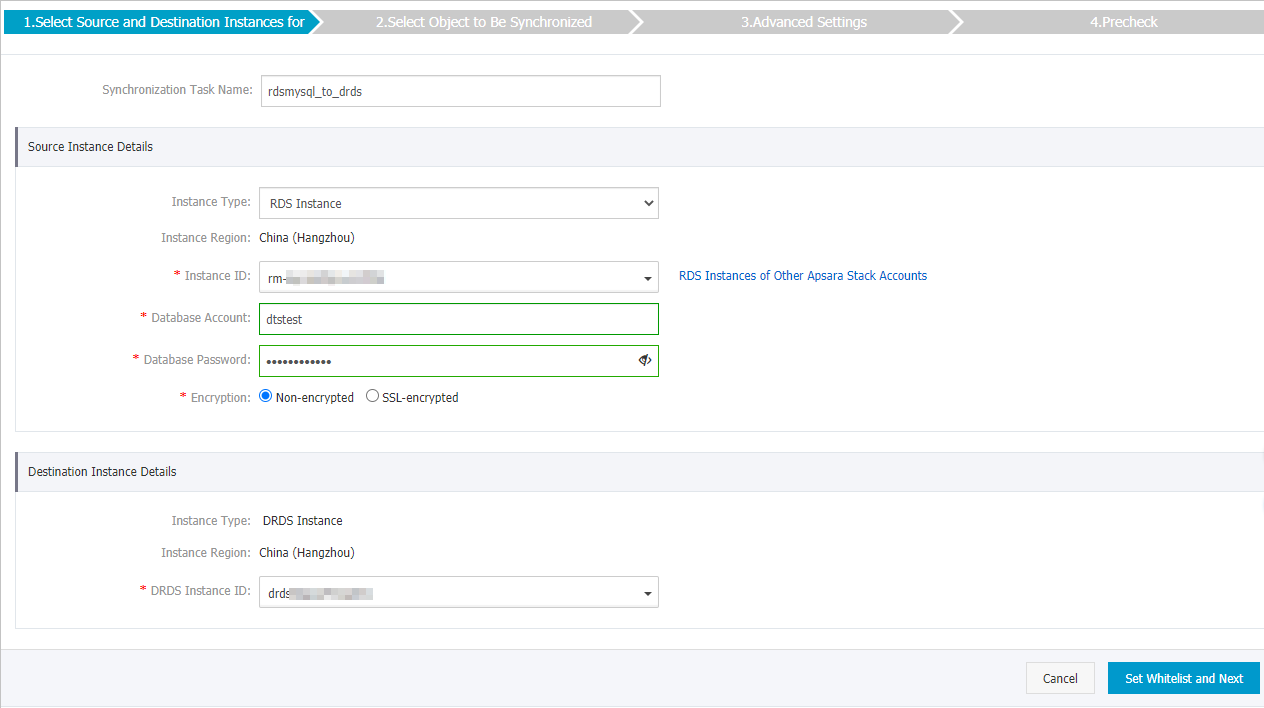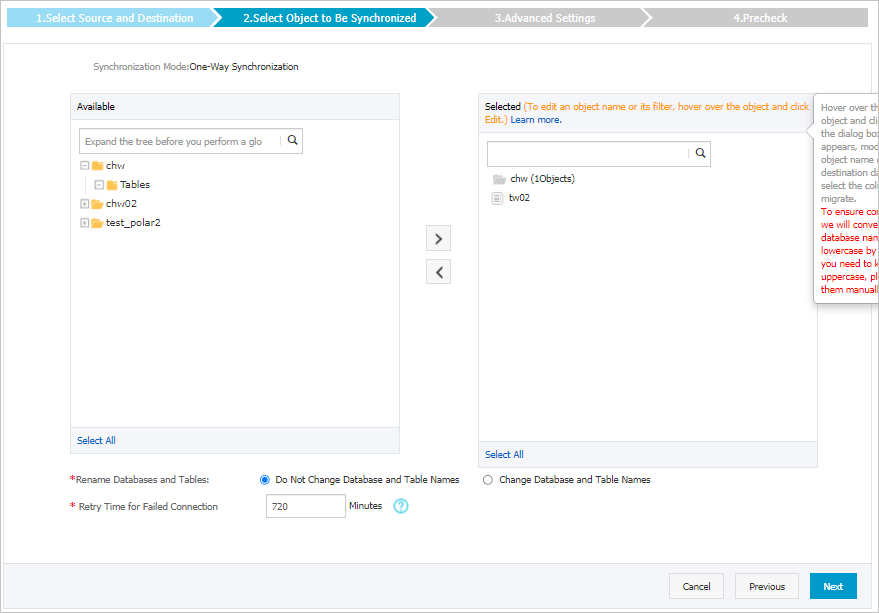PolarDB-X is developed by Alibaba Cloud to address the bottleneck of single-host database services. DRDS is compatible with the MySQL protocol and syntax, and supports automatic sharding, online smooth scaling, auto scaling, and transparent read and write splitting. DRDS provides O&M capabilities throughout the lifecycle of databases. This topic describes how to synchronize data from an ApsaraDB RDS for MySQL instance to a PolarDB-X instance by using Data Transmission Service (DTS).
Prerequisites
- The tables to be synchronized from the source database contain primary keys.
- The destination database has sufficient storage space.
- A PolarDB-X instance is created. For more information, see Create a instance and Create a database. Note When you create an instance, you must select RDS MySQL as the storage type.
Precautions
- DTS uses read and write resources of the source and destination databases during initial full data synchronization. This may increase the loads of the database servers. If the database performance or specifications are unfavorable, or the data volume is large, database services may become unavailable. For example, DTS occupies a large amount of read and write resources in the following cases: a large number of slow SQL queries are performed on the source database, the tables have no primary keys, or a deadlock occurs in the destination database. Before you synchronize data, evaluate the impact of data synchronization on the performance of the source and destination databases. We recommend that you synchronize data during off-peak hours. For example, you can synchronize data when the CPU utilization of the source and destination databases is less than 30%.
- During initial full data synchronization, concurrent INSERT operations cause fragmentation in the tables of the destination cluster. After initial full data synchronization, the tablespace of the destination cluster is larger than that of the source database. The destination database has sufficient storage space.
- DTS does not synchronize schemas from an ApsaraDB RDS for MySQL instance to a PolarDB-X instance. Before you configure a data synchronization task, you must create databases and tables in the destination instance.
Limits
- You can select only tables as the objects to be synchronized.
- DTS does not synchronize the following types of data: BIT, VARBIT, GEOMETRY, ARRAY, UUID, TSQUERY, TSVECTOR, TXID_SNAPSHOT, and POINT.
- Prefix indexes cannot be synchronized. If the source database contains prefix indexes, data may fail to be synchronized.
- We recommend that you do not use gh-ost or pt-online-schema-change to perform DDL operations on objects during data synchronization. Otherwise, data synchronization may fail.
SQL operations that can be synchronized
INSERT, UPDATE, and DELETE
Permissions required for database accounts
| Database | Required permissions |
|---|---|
| ApsaraDB RDS for MySQL | The SELECT permission on the objects to be synchronized, the REPLICATION CLIENT permission, the REPLICATION SLAVE permission, and the SHOW VIEW permission |
| PolarDB-X | DTS automatically creates a database account and grants permissions to the account. You do not need to specify the database account. |
Supported synchronization topologies
- One-way one-to-one synchronization
- One-way many-to-one synchronization
Before you begin
When you synchronize data from an ApsaraDB RDS for MySQL instance to a PolarDB-X instance, note that DTS does not support initial schema synchronization. Therefore, you must create databases and tables in the destination instance based on the schemas of the objects in the source ApsaraDB RDS for MySQL instance. For more information, see Create a database and Create a table.
Procedure
- Purchase a data synchronization instance. For more information, see Purchase a DTS instance. Note On the buy page, set Source Instance to MySQL, set Destination Instance to DRDS, and set Synchronization Topology to One-way Synchronization.
- Log on to the DTS console. Note If you are redirected to the Data Management (DMS) console, you can click the
 icon in the lower-right corner to go to the previous version of the DTS console.
icon in the lower-right corner to go to the previous version of the DTS console. - In the left-side navigation pane, click Data Synchronization.
- In the upper part of the Data Synchronization Tasks page, select the region in which the destination instance resides.
- Find the data synchronization instance and click Configure Task in the Actions column.
- Configure the source and destination instances.

Section Parameter Description N/A Synchronization Task Name DTS automatically generates a task name. We recommend that you specify an informative name to identify the task. You do not need to use a unique task name. Source Instance Details Instance Type Select RDS Instance. Instance Region The source region that you selected on the buy page. You cannot change the value of this parameter. Instance ID Select the ID of the source ApsaraDB RDS for MySQL instance. Database Account Enter the database account of the source RDS instance. For information about the permissions that are required for the account, see Permissions required for database accounts. Note If the database engine of the source RDS instance is MySQL 5.5 or MySQL 5.6, you do not need to configure the database account or database password.Database Password Enter the password of the database account. Encryption Select Non-encrypted or SSL-encrypted. If you want to select SSL-encrypted, you must enable SSL encryption for the RDS instance before you configure the data synchronization task. For more information, see Configure SSL encryption for an ApsaraDB RDS for MySQL instance. Important The Encryption parameter is available only within regions in the Chinese mainland and the China (Hong Kong) region.Destination Instance Details Instance Type This parameter is set to DRDS Instance and cannot be changed. Instance Region The destination region that you selected on the buy page. You cannot change the value of this parameter. DRDS Instance ID Select the ID of the destination DRDS instance. - In the lower-right corner of the page, click Set Whitelist and Next. Note
- You do not need to modify the security settings for ApsaraDB instances (such as ApsaraDB RDS for MySQL and ApsaraDB for MongoDB) and ECS-hosted databases. DTS automatically adds the CIDR blocks of DTS servers to the whitelists of ApsaraDB instances or the security group rules of Elastic Compute Service (ECS) instances. For more information, see Add the CIDR blocks of DTS servers to the security settings of on-premises databases.
- After data synchronization is complete, we recommend that you remove the CIDR blocks of DTS servers from the whitelists or security groups.
- Select the synchronization policy and the objects to be synchronized.

Setting Description Select the objects to be synchronized Select one or more tables from the Available section and click the
 icon to move the tables to the Selected section. Note
icon to move the tables to the Selected section. Note- You can select only tables as the objects to be synchronized.
- By default, after an object is synchronized to the destination instance, the name of the object remains unchanged. You can use the object name mapping feature to rename the objects that are synchronized to the destination instance. For more information, see Rename an object to be synchronized.
Rename Databases and Tables You can use the object name mapping feature to rename the objects that are synchronized to the destination instance. For more information, see Object name mapping.
Retry Time for Failed Connections By default, if DTS fails to connect to the source or destination database, DTS retries within the next 720 minutes (12 hours). You can specify the retry time based on your needs. If DTS reconnects to the source and destination databases within the specified time, DTS resumes the data synchronization task. Otherwise, the data synchronization task fails.Note When DTS retries a connection, you are charged for the DTS instance. We recommend that you specify the retry time based on your business needs. You can also release the DTS instance at your earliest opportunity after the source and destination instances are released. - Click Next.
- Specify whether you want to perform initial full data synchronization.
 Note During initial full data synchronization, DTS synchronizes the historical data of the required objects from the source database to the destination database. If you do not select Initial Full Data Synchronization, DTS does not synchronize the historical data.
Note During initial full data synchronization, DTS synchronizes the historical data of the required objects from the source database to the destination database. If you do not select Initial Full Data Synchronization, DTS does not synchronize the historical data. - In the lower-right corner of the page, click Precheck. Note
- Before you can start the data synchronization task, DTS performs a precheck. You can start the data synchronization task only after the task passes the precheck.
- If the task fails to pass the precheck, click the
 icon next to each failed item to view details.
icon next to each failed item to view details. - After you troubleshoot the issues based on the causes, run a precheck again.
- If you do not need to troubleshoot the issues, ignore failed items and run a precheck again.
- Close the Precheck dialog box after the following message is displayed: Precheck Passed. Then, the data synchronization task starts.
- Wait until initial synchronization is complete and the data synchronization task enters the Synchronizing state. You can view the status of the data synchronization task on the Synchronization Tasks page.
